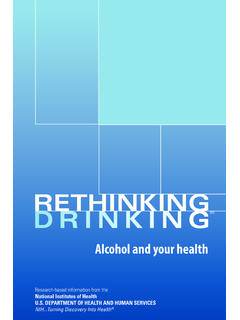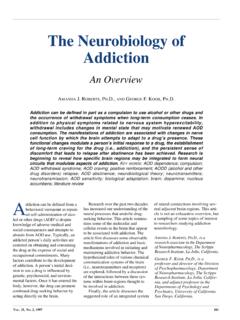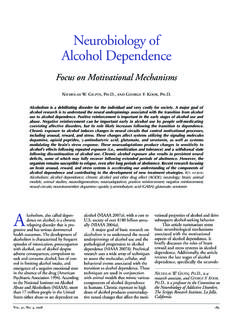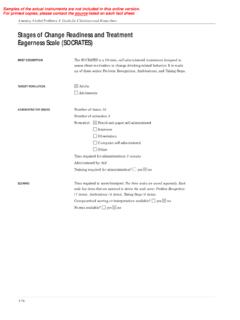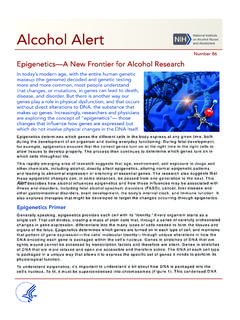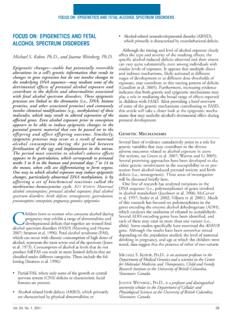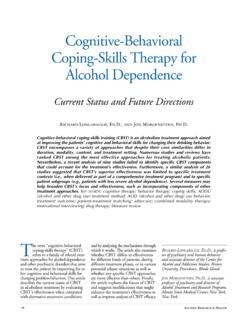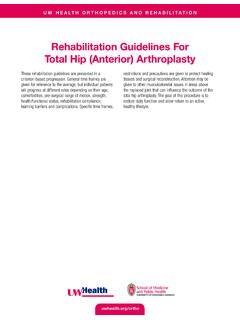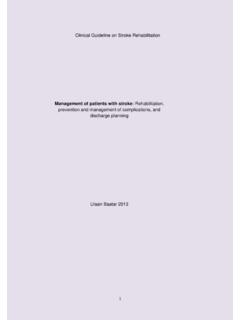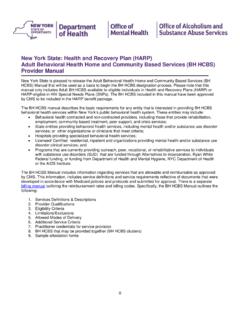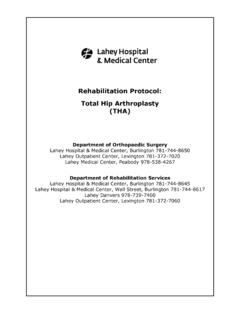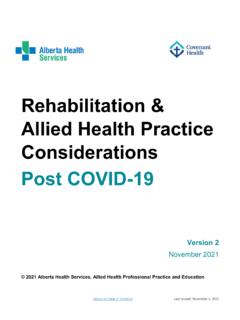Transcription of An Overview of Outpatient and Inpatient Detoxification
1 44 Alcohol Health & Research Worldlcohol Detoxification can be defined as a periodof medical treatment, usually including counsel-ing, during which a person is helped to overcomephysical and psychological dependence on alcohol (Changand Kosten 1997). The immediate objectives of alcoholdetoxification are to help the patient achieve a substance-free state, relieve the immediate symptoms of withdrawal,and treat any comorbid medical or psychiatric objectives help prepare the patient for entry intolong-term treatment or rehabilitation , the ultimate goalof Detoxification (Swift 1997).
2 The objectives of long-term treatment or rehabilitation include the long-termmaintenance of the alcohol-free state and the incor-poration of psychological, family, and social interven-tions to help ensure its persistence (Swift 1997). Alcohol Detoxification can be completed safely andeffectively in both Inpatient and Outpatient treatmentsettings. This article describes the advantages and disad-vantages of Inpatient and Outpatient detoxificationprograms and considers the influence that the detoxificationsetting may have on long-term treatment outcomes.
3 Outpatient and Inpatient DetoxificationPatients receiving Outpatient Detoxification treatmentusually are expected to travel to a hospital or othertreatment facility daily (excluding weekends) fortreatment sessions. The sessions may be scheduled fordaytime or evening hours, depending on the initial assessment, including intake history, physicalexamination, ordering of laboratory studies, and theinitiation of Detoxification treatment, usually takes 1to 2 hours on the first day of Outpatient sessions may range from 15 to 30 the Detoxification program is combined with a dayhospital program, sessions can last several hours perday.
4 The duration of treatment may range from 3 to14 days. In one study, the average duration of treatmentfor outpatientswas days, significantly shorter thanthe average duration for Inpatient Detoxification ( , 9days) (Hayashida et al. 1989). Patients receivinginpatient care are admitted to a hospital or otherfacility, where they reside for the duration oftreatment, which may range from 5 to 14 process of Detoxification in either setting initiallyinvolves the assessment and treatment of acute with-drawal symptoms, which may range from mild ( ,tremor and insomnia) to severe ( , autonomichyperactivity, seizures, and delirium) (Swift 1997).
5 Medications often are provided to help reduce a patient swithdrawal symptoms. Benzodiazepines ( , diazepamand chlordiazepoxide) are the most commonly useddrugs for this purpose, and their efficacy is well estab-lished (Swift 1997). Benzodiazepines not only reducealcohol withdrawal symptoms but also prevent alcoholwithdrawal seizures, which occur in an estimated 1 to4 percent of withdrawal patients (Schuckit 1995). Anticonvulsant medications are necessary in addi-tion to benzodiazepines for patients with a history ofseizures unrelated to alcohol withdrawal (Sellers andNaranjo 1986).
6 Additional components of alcoholdetoxificationmay include education and counseling tohelp the patient prepare for long-term treatment, atten-dance at Alcoholics Anonymous meetings, recreationaland social activities, and medical or surgical of Outpatient DetoxificationFor patients with mild-to-moderate alcohol withdrawalsyndrome, characterized by symptoms such as handtremor, perspiration, heart palpitation, restlessness, lossof appetite, nausea, and vomiting, Outpatient detox -ification is as safe and effective as Inpatient detoxificationbut is much less expensive and less time consuming(Hayashida et al.)
7 1989). In addition, patients who enroll in long-term Outpatient rehabilitation treatmentfollowing Detoxification in an Outpatient setting maybenefit by attending the same treatment facility forboth phases of treatment. Most outpatients experiencegreater social support than inpatients, with the exceptionof outpatients in especially adverse family circumstances orjob situations. Outpatients can continue to functionrelatively normallyand maintain employment as well as family and social relationships. Compared withinpatients, those patients in Outpatient treatment retaingreater freedom, continue to work and maintain day-to-day activities with fewer disruptions, and incurfewer treatment , , , is an Honorable Professorof Psychiatry at Keio University, Tokyo; adjunct professorof psychiatry at University of Pennsylvania, Philadelphia;and medical director of Yokohama Maioka PsychiatricHospital, Tokyo, Overview of Outpatient and Inpatient DetoxificationMotoi Hayashida, , 22, No.
8 1, 199845 Disadvantages of Outpatient DetoxificationAmong the drawbacks associated with outpatientdetoxification is the increased risk of relapse resultingfrom the patient s easy access to alcoholic beverages. Inaddition, outpatients can more easily choose not to keeptheir Detoxification appointments and, consequently,fail to complete Detoxification . In one study of 164patients randomly assigned to either Inpatient or out-patient Detoxification ,significantly more inpatients thanoutpatients completed Detoxification (Hayashida et ).
9 The higher completion rate among inpatientsshould not be interpreted as an indicator of long-termsobriety, however. Inpatients who suc-cessfully completed Detoxification mighthave either dropped out of treatmentor returned to drinkinghad they beentreated in the Outpatient setting. Thus,although inpatients may be more likelyto complete Detoxification , they maybe arbitrarily postponing the chanceto resume drinking after Detoxification is notappropriate for all patients. Mostalcohol treatment programs find thatfewer than 10 percent of patientswith alcohol withdrawal symptomswill need admission to an inpatientunit (Abbott et al.)
10 1995). Outpatientdetoxification is not safe for alcoholics at risk for poten-tially life-threatening complications of withdrawal,such as delirium tremens, or those with associatedmedical conditions such as pancreatitis, gastrointesti-nal bleeding, or cirrhosis. In addition, outpatientdetoxification is not appropriate for suicidal or homici-dal patients, those with severe or medically complicatedalcohol withdrawal, patients in adverse or disruptivefamily or job situations, or patients who would not beable to travel daily to the treatment of Inpatient DetoxificationPatients for whom Outpatient Detoxification is not appro-priate become candidates for Inpatient Detoxification .
